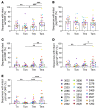The HIV-1 proviral landscape reveals that Nef contributes to HIV-1 persistence in effector memory CD4+ T cells
- PMID: 35133986
- PMCID: PMC8970682
- DOI: 10.1172/JCI154422
The HIV-1 proviral landscape reveals that Nef contributes to HIV-1 persistence in effector memory CD4+ T cells
Abstract
Despite long-term antiretroviral therapy (ART), HIV-1 persists within a reservoir of CD4+ T cells that contribute to viral rebound if treatment is interrupted. Identifying the cellular populations that contribute to the HIV-1 reservoir and understanding the mechanisms of viral persistence are necessary to achieve an effective cure. In this regard, through Full-Length Individual Proviral Sequencing, we observed that the HIV-1 proviral landscape was different and changed with time on ART across naive and memory CD4+ T cell subsets isolated from 24 participants. We found that the proportion of genetically intact HIV-1 proviruses was higher and persisted over time in effector memory CD4+ T cells when compared with naive, central, and transitional memory CD4+ T cells. Interestingly, we found that escape mutations remained stable over time within effector memory T cells during therapy. Finally, we provided evidence that Nef plays a role in the persistence of genetically intact HIV-1. These findings posit effector memory T cells as a key component of the HIV-1 reservoir and suggest Nef as an attractive therapeutic target.
Keywords: AIDS/HIV; Adaptive immunity; Infectious disease; Molecular genetics; T cells.
Figures










Comment in
-
Hide and seek: for HIV-infected CD4+ T cells, playing well comes with maturity.J Clin Invest. 2022 Apr 1;132(7):1-4. doi: 10.1172/JCI158872. J Clin Invest. 2022. PMID: 35362485 Free PMC article.
Similar articles
-
Genetic Diversity, Compartmentalization, and Age of HIV Proviruses Persisting in CD4+ T Cell Subsets during Long-Term Combination Antiretroviral Therapy.J Virol. 2020 Feb 14;94(5):e01786-19. doi: 10.1128/JVI.01786-19. Print 2020 Feb 14. J Virol. 2020. PMID: 31776273 Free PMC article.
-
HIV-1 Genomes Are Enriched in Memory CD4+ T-Cells with Short Half-Lives.mBio. 2021 Oct 26;12(5):e0244721. doi: 10.1128/mBio.02447-21. Epub 2021 Sep 21. mBio. 2021. PMID: 34544282 Free PMC article.
-
Persistence of an intact HIV reservoir in phenotypically naive T cells.JCI Insight. 2020 Oct 15;5(20):e133157. doi: 10.1172/jci.insight.133157. JCI Insight. 2020. PMID: 33055422 Free PMC article.
-
New Approaches to Multi-Parametric HIV-1 Genetics Using Multiple Displacement Amplification: Determining the What, How, and Where of the HIV-1 Reservoir.Viruses. 2021 Dec 10;13(12):2475. doi: 10.3390/v13122475. Viruses. 2021. PMID: 34960744 Free PMC article. Review.
-
Single-molecule techniques to quantify and genetically characterise persistent HIV.Retrovirology. 2018 Jan 9;15(1):3. doi: 10.1186/s12977-017-0386-x. Retrovirology. 2018. PMID: 29316955 Free PMC article. Review.
Cited by
-
Long-term antiretroviral therapy rejuvenates the HIV-specific CD8+ T cell response.Nat Immunol. 2024 Sep;25(9):1513-1514. doi: 10.1038/s41590-024-01924-8. Nat Immunol. 2024. PMID: 39179933 No abstract available.
-
The immunosuppressive tuberculosis-associated microenvironment inhibits viral replication and promotes HIV-1 latency in CD4+ T cells.iScience. 2024 Jun 20;27(7):110324. doi: 10.1016/j.isci.2024.110324. eCollection 2024 Jul 19. iScience. 2024. PMID: 39055929 Free PMC article.
-
A fluorescence polarization assay for high-throughput screening of inhibitors against HIV-1 Nef-mediated MHC-I downregulation.J Biol Chem. 2024 Aug;300(8):107529. doi: 10.1016/j.jbc.2024.107529. Epub 2024 Jul 1. J Biol Chem. 2024. PMID: 38960039 Free PMC article.
-
PROTAC-mediated degradation of HIV-1 Nef efficiently restores cell-surface CD4 and MHC-I expression and blocks HIV-1 replication.Cell Chem Biol. 2024 Apr 18;31(4):658-668.e14. doi: 10.1016/j.chembiol.2024.02.004. Epub 2024 Mar 19. Cell Chem Biol. 2024. PMID: 38508197
-
Persistent HIV-1 transcription during ART: time to reassess its significance?Curr Opin HIV AIDS. 2024 May 1;19(3):124-132. doi: 10.1097/COH.0000000000000849. Epub 2024 Mar 12. Curr Opin HIV AIDS. 2024. PMID: 38502547 Free PMC article. Review.
References
Publication types
MeSH terms
Substances
Grants and funding
LinkOut - more resources
Full Text Sources
Medical
Molecular Biology Databases
Research Materials

